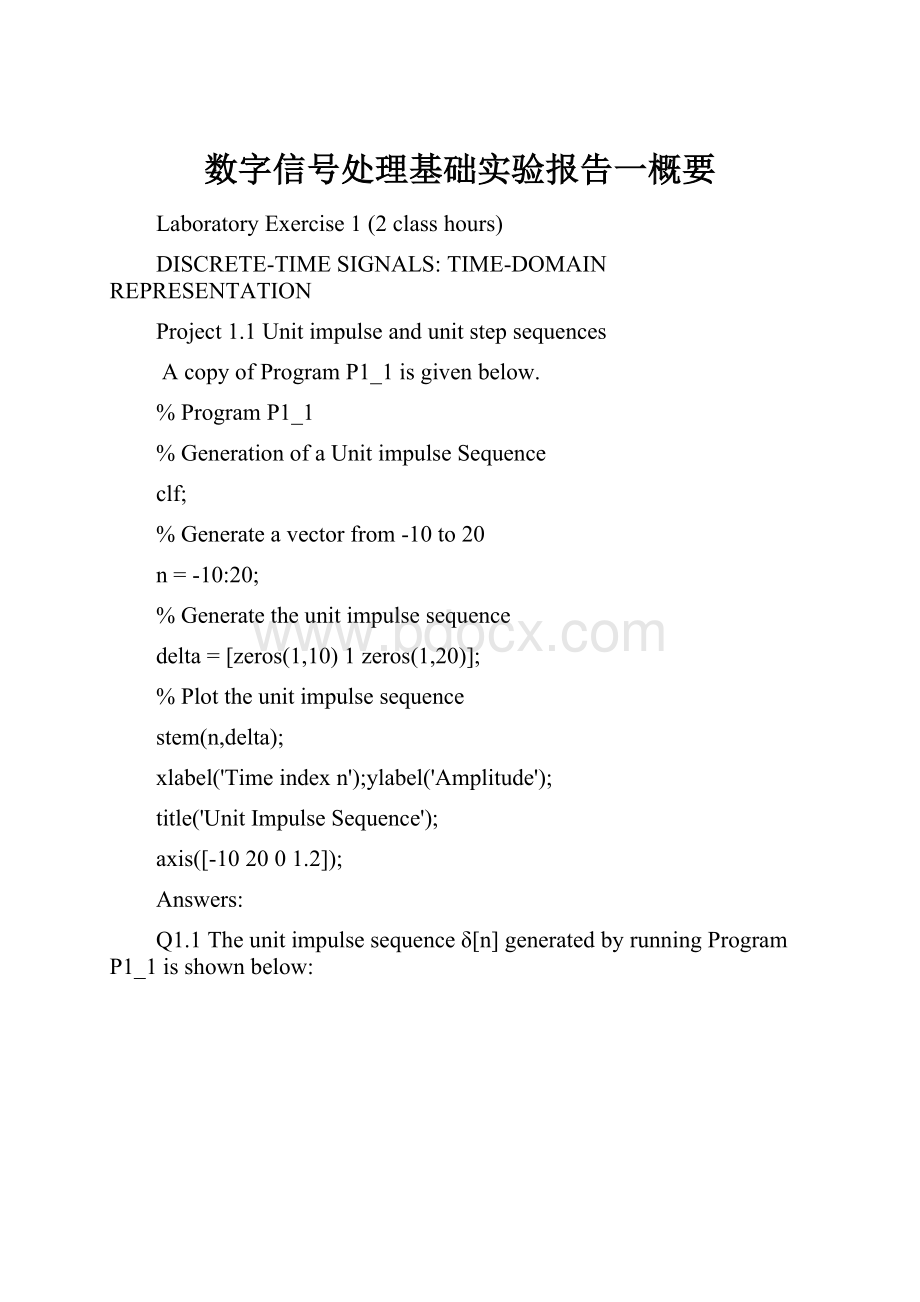数字信号处理基础实验报告一概要.docx
《数字信号处理基础实验报告一概要.docx》由会员分享,可在线阅读,更多相关《数字信号处理基础实验报告一概要.docx(16页珍藏版)》请在冰豆网上搜索。

数字信号处理基础实验报告一概要
LaboratoryExercise1(2classhours)
DISCRETE-TIMESIGNALS:
TIME-DOMAINREPRESENTATION
Project1.1Unitimpulseandunitstepsequences
AcopyofProgramP1_1isgivenbelow.
%ProgramP1_1
%GenerationofaUnitimpulseSequence
clf;
%Generateavectorfrom-10to20
n=-10:
20;
%Generatetheunitimpulsesequence
delta=[zeros(1,10)1zeros(1,20)];
%Plottheunitimpulsesequence
stem(n,delta);
xlabel('Timeindexn');ylabel('Amplitude');
title('UnitImpulseSequence');
axis([-102001.2]);
Answers:
Q1.1Theunitimpulsesequenceδ[n]generatedbyrunningProgramP1_1isshownbelow:
Q1.2ThemodifiedProgramP1_1togenerateadelayedunitsamplesequenceδd[n]withadelayof11samplesisgivenbelowalongwiththesequencegeneratedbyrunningthisprogram.
%ProgramQ1.2
%GenerationofaUnitimpulseSequencewithadelayof11samples
clf;
n=-10:
20;
delta=[zeros(1,21)1zeros(1,9)];
stem(n,delta);
xlabel('Timeindexn');ylabel('Amplitude');
title('UnitImpulseSequencewithadelayof11samples');
axis([-102001.2]);
Q1.3ThemodifiedProgramP1_1togenerateaunitstepsequenceu[n]isgivenbelowalongwiththesequencegeneratedbyrunningthisprogram.
%ProgramQ1.3
%Generationofaunitstepsequence
clf;
n=-10:
20;
delta=[zeros(1,10),ones(1,21)];
stem(n,delta);
xlabel('Timeindexn');ylabel('Amplitude');
title('UnitStepSequence');
axis([-102001.2]);
Q1.4ThemodifiedProgramP1_1togenerateaunitstepsequenceud[n]withanadvanceof7samplesisgivenbelowalongwiththesequencegeneratedbyrunningthisprogram.
%ProgramQ1.4
%Generationofaunitstepsequencewithanadvanceof7samples
clf;
n=-10:
20;
delta=[zeros(1,17),ones(1,14)];
stem(n,delta);
xlabel('Timeindexn');ylabel('Amplitude');
title('UnitStepSequencewithanadvanceof7samples');
axis([-102001.2]);
Project1.2Exponentialsignals
AcopyofProgramsP1_2andP1_3aregivenbelow.
%ProgramP1_2
%Generationofacomplexexponentialsequence
clf;
c=-(1/12)+(pi/6)*i;
K=2;
n=0:
40;
x=K*exp(c*n);
subplot(2,1,1);
stem(n,real(x));
xlabel('Timeindexn');ylabel('Amplitude');
title('Realpart');
subplot(2,1,2);
stem(n,imag(x));
xlabel('Timeindexn');ylabel('Amplitude');
title('Imaginarypart');
%ProgramP1_3
%Generationofarealexponentialsequence
clf;
n=0:
35;a=1.2;K=0.2;
x=K*a.^n;
stem(n,x);
xlabel('Timeindexn');ylabel('Amplitude');
Answers:
Q1.5Thecomplex-valuedexponentialsequencegeneratedbyrunningProgramP1_2isshownbelow:
Q1.6Thepurposeoftheoperatorrealis:
Complexrealpart.确定一个复数或矩阵的实部;
Thepurposeoftheoperatorimagis:
Compleximagepart.确定一个复数或矩阵的虚部.
Q1.7Thepurposeofthecommandsubplotis:
Createaxesintiledpositions.(将图形窗口分成多个矩形窗格来显示多个图形)
Q1.8Thereal-valuedexponentialsequencegeneratedbyrunningProgramP1_3isshownbelow:
Q1.9Thedifferencebetweenthearithmeticoperators^and.^is:
^数值乘方,而.^矩阵乘方。
Q1.10Thelengthofthissequenceis36.
ItiscontrolledbythefollowingMATLABcommandline:
n=0:
35.
Q1.11Theenergiesofthereal-valuedexponentialsequencesx[n]generatedinQ1.8computedusingthecommandsumare:
sum(abs(x).*abs(x));
Theenergyofasequencex[n]isdefinedas
Project1.3Sinusoidalsequences
AcopyofProgramP1_4isgivenbelow.
%ProgramP1_4
%Generationofasinusoidalsequence
n=0:
40;
f=0.1;
phase=0;
A=1.5;
arg=2*pi*f*n-phase;
x=A*cos(arg);
clf;%Clearoldgraph
stem(n,x);%Plotthegeneratedsequence
axis([040-22]);
grid;
title('SinusoidalSequence');
xlabel('Timeindexn');
ylabel('Amplitude');
axis;
Answers:
Q1.12ThesinusoidalsequencegeneratedbyrunningProgramP1_4isdisplayedbelow.
Q1.13Theaveragepowerofthegeneratedsinusoidalsequenceis:
P=sum(abs(x).*abs(x))/length(n);
Theaveragepowerofperiodicalsignal
isdefinedas
,whereNistheperiodof
.
Q1.14Thepurposeofaxiscommandis:
Controlaxisscalingandappearance.(手工设置图中坐标尺度)
Thepurposeofgridcommandis:
Gridlines.(在当前图形上增加或减少网络线)
Q1.15Thesinusoidalsequenceoflength50,frequency0.08,amplitude2.5,andphaseshiftof90degreesgeneratedbymodifyingProgramP1_4isdisplayedbelow.
Q1.16ByreplacingthestemcommandinProgramP1_4withtheplotcommand,theplotobtainedisasshownbelow:
Q1.17ByreplacingthestemcommandinProgramP1_4withthestairscommandtheplotobtainedisasshownbelow:
Project1.4SamplingofaSinusoidalSignal
AcopyofProgramP1_5isgivenbelow:
Answers:
Q1.18Theplotsofthecontinuous-timesignalanditssampledversiongeneratedbyrunningProgramP1_5areshownbelow:
Q1.19Theplotsofthecontinuous-timesinusoidalsignaloffrequency3HzanditssampledversiongeneratedbyrunningamodifiedProgramP1_5areshownbelow:
Theplotsofthecontinuous-timesinusoidalsignaloffrequency7HzanditssampledversiongeneratedbyrunningamodifiedProgramP1_5areshownbelow:
Basedontheseresultswemakethefollowingobservations
Project1.5Drawthefollowingsignals
Q1.20
clc;clear;closeall;
clf;
n=-10:
20;
delta1=[zeros(1,10),ones(1,21)];
delta2=[ones(1,18),zeros(1,13)];
delta=delta1.*delta2;
stem(n,delta);
xlabel('Timeindexn');ylabel('Amplitude');
title('x[n]=u[n]u[7-n]');
axis([-102001.2]);
Q1.21
clc;clear;closeall;
clf;
n=-10:
20;
delta=[zeros(1,10),ones(1,21)];
x=0.5*exp(-0.3*n).*sin(n*pi/4).*delta;
stem(n,x);
xlabel('Timeindexn');ylabel('Amplitude');
title('x[n]=0.5exp(-0.3n)sin(n*pi/4)u[n]');
Q1.22
clc;clear;closeall;
clf;
n=-10:
20;
delta=[zeros(1,10),ones(1,21)];
x=3*sin(n*pi/5-2*pi/9).*delta;
stem(n,x);
xlabel('Timeindexn');ylabel('Amplitude');
title('x[n]=3*sin(n*pi/5-2*pi/9)u[n]');
%axis([-10200.41.2]);